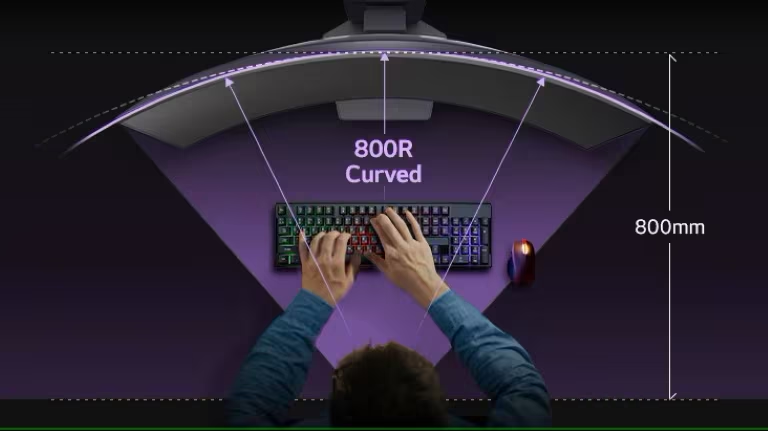I’ve tested a number of curved gaming monitors over the past year, mostly models between 1500R and 1800R curvature. Both options offer a more immersive experience compared to flat displays, but the difference between them is more noticeable in daily use than I expected.
The first few days with a 1500R monitor felt intense. The curve was deeper than what I was used to, especially coming from a more subtle 1800R display. For fast-paced games like Apex, Forza, or Call of Duty, that tighter curve immediately pulled me in. It took less head movement to track targets, and the edges of the screen stayed comfortably in view. That curved wrap felt natural in a way flat monitors never did.
What made this difference stand out the most was my time with the Gigabyte G32QC A, which uses a 1500R VA panel. It’s a 32-inch, 165Hz QHD monitor that I picked up to test curved immersion at a more competitive price point. I wasn’t expecting much, but after a few evenings with it, I didn’t want to go back. It fits right in that sweet spot when comparing 1000R vs 1500R vs 1800R, with the best balance of curve and usability.
The display offers 93% DCI-P3 colour coverage and DisplayHDR400 support. The contrast is excellent, blacks stay deep, and the colour saturation is far better than I’d expect from a monitor in this price range. If you’re considering stepping up to a 1500R panel, this one’s hard to overlook. Here’s where I got mine.
1800R Still Has Its Place
Switching back to an 1800R panel felt more relaxed. The screen was still curved, but not as aggressive. I used an 1800R model for productivity for nearly four months and found it easier to manage windows and text-heavy work. Curves were there, but subtle. Lines stayed cleaner, and there was less optical strain.
If your priority is multitasking, reading, or long hours of non-gaming use, I’d lean toward 1800R. It’s less demanding on the eyes and generally more forgiving. But in games? I found myself missing that deeper curve fairly quickly. For anyone trying to decide between 1500R vs 1800R curved monitors in a work-and-play scenario, 1800R might edge out.
There’s more detail on this comparison in the dedicated 1500R vs 1800R curved monitor guide on Mamija Gaming. It helped me look at things like curvature vs viewing angle, and how those differences translate into real-world use.
Why 1500R Became My Preference for Gaming
Over time, the tighter 1500R displays just felt better for the way I play. The curve helps draw attention to the centre of the screen and keeps peripheral vision engaged. I noticed it most in tactical shooters and racing sims, where screen awareness matters.
The G32QC A made the biggest impression. Besides the 165Hz refresh rate, which really showed its strength in CS2, what stood out was how stable it felt in motion. The 1ms MPRT spec actually translates well. Ghosting was minimal, and even darker scenes looked clean. FreeSync Premium Pro handled variable framerates reliably, especially on my RX 6700 XT test build.
It isn’t a perfect display. The stand is basic, there’s no USB passthrough, and peak brightness could be higher. But for the money, it’s easily one of the better curved monitors I’ve tested this year. And I’m not alone. It also made the shortlist in our Top 5 Curved Gaming Monitors article over on BestMonitorRadar.
Final Thoughts
Both 1500R and 1800R have their strengths, and which one you should go for depends on how you use your monitor. If you spend your time browsing, coding, or juggling spreadsheets, 1800R is safer. But if your setup is built for gaming and immersion matters, then 1500R is the direction I’d recommend.
There are differences that specs alone won’t tell you. You need time in front of each to know what feels right. In my case, after nearly a year of back-and-forth testing between 1500R vs 1800R monitors, I kept coming back to 1500R. That deeper curve just works better for how I play.
For anyone comparing curved monitor 1500R vs 1800R models today, the best approach is to think about how you actually use your screen. For me, the 1500R curve continues to offer the right balance of immersion, speed, and visual comfort.





























